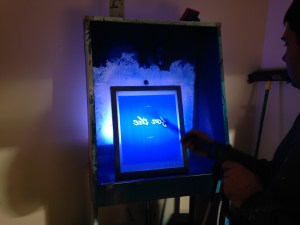In about 90 minutes I leave the real world to enter the shadowy territory of H.O. Studley. His tool cabinet and workbench are under the kind curation of a man who wishes to remain anonymous. And so we turn off all the location services on our smart devices.
During this final visit, we will shoot a video about the chest, including a time-lapse film of us unloading it. And we will finish all the extra still photos we need for Don Williams’ forthcoming book, “Virtuoso: The Tool Cabinet and Workbench of H.O. Studley.”
Don is almost finished with his manuscript. I have read his first draft, and Don has uncovered a lot of information on Studley himself and the interesting journey of the chest from Quincy, Mass., to the wall of a collector’s Batcave.
The photos, by Narayan Nayar, are of museum quality.
The book will be released in March 2015, just in time for the (perhaps final) public exhibit of the chest and workbench that coincides with the Handworks event in the Amana Colonies, May 15-16, 2015. Don’t miss Handworks. Seriously. You will kick yourself if you do. Nothing else embodies the ideas of hand-tool woodworking that we hold dear at Lost Art Press. It’s not a commercial thing. There are no guys selling router bits. No Sham-wows. Just lots of people who love handwork having a good time. Admission is free.
The Studley exhibit will be held at the Masonic lodge in nearby Cedar Rapids, Iowa. The exhibit is being funded entirely out of Don Williams’ pocket with some volunteer help. There is no corporate or museum money behind him. This is, frankly, a huge risk on Don’s part.
When Don visited here recently I asked him about the exhibit and if he would cancel it if he didn’t sell enough tickets. He replied, “No.” After I asked the obvious follow-up, “Why?” here’s the answer I received.
“Because it has to be done. This might be the only chance for people to ever see these objects. And,” he added, ”I said that I would do it.”
If you are thinking about attending or just want to support this kind of quixotic endeavor, buy your tickets at http://www.studleytoolchestexhibit.com/. Tickets are only $25.
— Christopher Schwarz
















